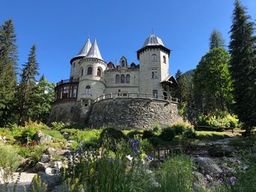The Aosta Valley, best known in winter for its ski resorts also hosts fantastic opportunities for touring castles and immersing in the rich cultural heritage of the region. In fact, the smallest region of Italy Aosta, is home to over 120 manor houses, strongholds and dungeons, all harmoniously set within nature.
Being the only possible route over the Alpine passes made Aosta a region that saw a large number of fortified structures being erected in the Middle Ages for the collection of tolls which conferred power and income. These first castles were mostly walled dungeons, with a purely defensive function: examples are the Castle of Graines, the Castle of Cly and Châtel-Argent. In the following centuries, the defensive function was flanked by the residential one – as in the Castle of Verrès or in the Castle of Ussel – and, even later, the former structure had completely disappeared in favour of an evolution into the creation of noble palaces, erected with the sole purpose of showing off the power and wealth of the owner. This is the case of the Castle of Fénis, the Castello di Issogne and the Castello di Aymavilles. Some of castles you can explore include:
Savoia Castle: built between 1899 and 1904, Savoia Castle in Gressonay-St-Jean was where Queen Margherita, widow of Umberto I, lived for many summers up to 1925, the year before she died. It was designed by Stramucci, who also designed the Neo-Baroque decor in the Royal Palace in Turin, and the Quirinale in Rome. Externally covered in grey stone from the quarries in Gressoney, Gaby and Vert, Savoy Castle is split over 3 floors comprised of living quarters, royal apartments and gentlemen’s rooms. The original kitchens were separate and connected by an underground railway. A few pieces of original furniture and some tapestries remain, as well as ornamental paintings by Cussetti and other furniture by Dellera. The foot of the manor hosts a rocky garden full of Alpine botanical species.
Fénis Castle: famous for its extraordinary architecture and the evocative power of its towers and turreted walls. This complex, harmonious structure, which is organised in a concentric manner around an inner courtyard, evokes an almost fairytale image. The castle towers were added to the pre-existing keep towards the mid 14th century by Aimone of Challant. The property was then owned by the Lords of Challant until 1716, before eventually being transformed into a country home, bought in 1895 by Alfred of Andrade. Fénis Castle has a pentagon layout with an inner courtyard decorated with amazing frescoes. Downstairs there’s a weapons and dining hall, and a chapel on the first floor.
Bard Fortress: during Theodoric’s reign in the 6th century, Bard was a defence garrison. Over the centuries it was constantly in the firing line and was once again the protagonist on Napoleon Bonaparte’s arrival in May 1800. The defensive structures of Bard Fortress were so efficient that Napoleon’s army took around two weeks to overcome the Austrian defences. The fortress was then dismantled to avoid further danger. What we see today is a reproduced building which evolved under Charles Felice who, starting in 1830, turned it into a military mass, although this started to deteriorate at the end of the 19th century. After more renovation in 1990 by the Region of Valle d’Aosta, it now hosts the Alps Museum and temporary exhibitions.
About Aosta Valley: The smallest region of Italy located in the Northwest of the country; Aosta Valley boasts spectacular scenery, world-class skiing and snowboarding, food of the highest quality and a history stretching back to Roman times. At the heart of the alps and bordered by France and Switzerland, Aosta valley is surrounded by some of the highest peaks in Europe: Cervino, Monte Rosa, Gran Paradiso and the king of them all, Mont Blanc, which at 15,781 feet is the highest mountain in Europe, the roof of the old Continent. With Turin, Milan and Geneva airports all within easy reach, the Aosta Valley resorts are among the easiest to get to from the UK making it an ideal destination for a weekend or short break.
For more information on Aosta Valley visit: www.aosta-valley.co.uk

